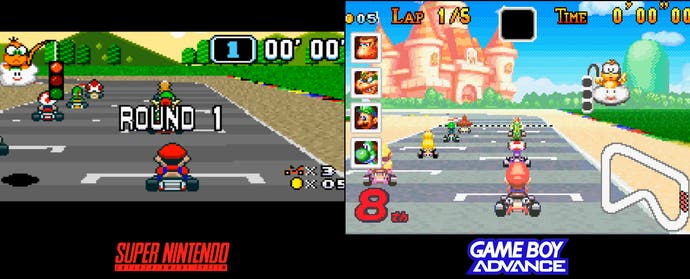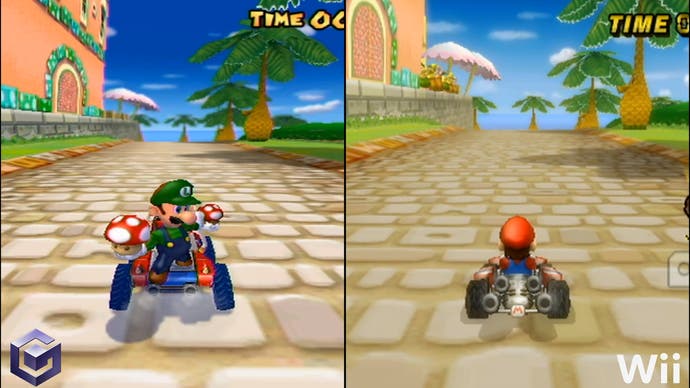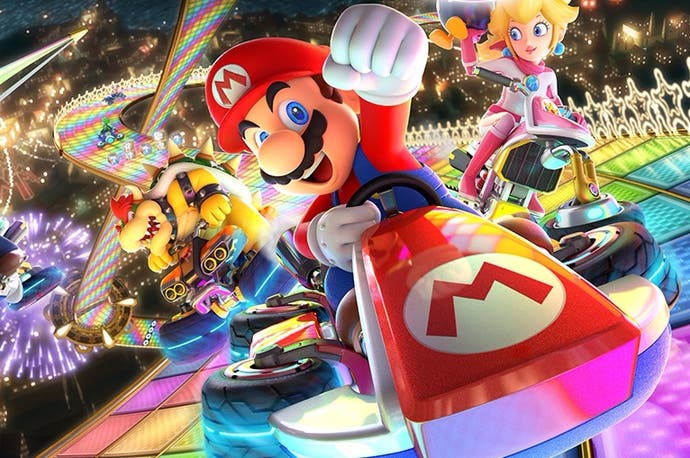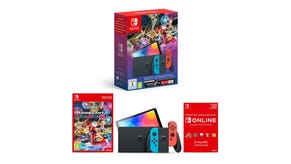Tech Evolution: 25 years of Super Mario Kart
Nine games analysed across nine consoles: Digital Foundry charts the evolution of the classic series.
Can you believe it? This week marks the 25th anniversary of Super Mario Kart - the original, pioneering Super Nintendo release. Many imitators have come and gone, but that 1992 release set the template for seven sequels - eight if you count the excellent Mario Kart 8 Deluxe on Switch - and we felt that was worthy of celebration. But beyond the anniversary itself, the importance of Mario Kart's evolution across the years is significant - each series entry defines the strengths and weaknesses of its host platform, and demonstrates the values, practises and philosophy that set Nintendo apart from its competition.
Just one example of this is its target performance level. With just one or two exceptions, every Mario Kart game ever released hit a full 60 frames per second. Of all the platform holders, Nintendo is by far the most wedded to the silky smooth, full frame-rate experience. It's almost essential for a driving game of course, but Zelda aside, it's the standard Nintendo sets for all of its major franchises.
It was much easier to achieve back in the day, before the advent of polygonal 3D, and that's where the Super Mario Kart story begins. Released in Japan on the 27th August 1992, nobody could have predicted the success the title would go on to have, or the legacy it'd create. Technically, we're looking at a humble beginning in some respects, with the Super Nintendo relying on its 256x224 output mode to CRT screens of the day. It's most famous though, alongside F-Zero, for its revolutionary use of Mode 7 graphics. A lot has already been said of the technique, but this was a landmark title for showing what it could do - and it's hard to miss; Mode 7 created a psuedo-3D look in SNES titles by rotating and scaling a background layer on top of 2D sprites.
These visuals may look primitive today, but it gave Super Nintendo a huge advantage over the competition at the time. Rotate and scale operations were handled natively on the Super Nintendo console - meaning no extra chip on the cartridges (though Super Mario Kart itself used the DSP1 processor on the cart to handle additional computations). Two picture processing units worked in tandem, taking a large 256x256 texture-mapped tile, and shifting the perspective from the conventional top-down view, to a more dynamic side angle. It creates the floor to Mario Kart's maps, and once 2D sprites are planted on top (with 22 variations to accommodate character rotation and three sets for distance), it gives a convincing illusion of 3D space using flat surfaces.
One curious aside: due to the way Super Mario Kart's engine was built, the game only played in split-screen. The idea here is that the title was optimised as a two-player game first and foremost, and so the horizontal split stayed even in the single-player mode. In Nintendo's eyes, F-Zero had been pitched as the faster, single-player racer to use Mode 7 graphics, a launch title for the console in Japan. But without a specific engine rewrite for Mario Kart's solo play, it left us with only a circuit map on the lower half of the screen. It's a focus on multiplayer that really set the precedent for how Nintendo saw the series going forward.
Super Mario Kart was, and still is, a special game, and plays beautifully to this day at a faultless 60 frames per second, even in two-player mode. The handling is still spot on, and even with the quirks of its pseudo-3D, the game has an air of timeless charm shared by many of the SNES's best games. The series would have a tricky transition to full 3D with the next series entry on Nintendo 64, but the platform holder wasn't done with Mode 7 - Mario Kart Super Circuit arived on the Game Boy Advance in 2001, and serves as more of an tangent to the series line. At its core, this is a spiritual successor to the Super Nintendo original, evolving its Mode 7-style graphics engine. It even featured all of the original game's levels in a retro section, leveraging the handheld's power to enhance them.
Even as a portable entry, Super Circuit added plenty to the package. Texture quality improved massively and item boxes were rendered as full sprites, though coins remained as flat textures on the floor. The circuits were better resolved with more tree sprites, enemies, pipes, and up to three scrolling parallax layers for the background, up from the basic two layers on SNES, while sprite data for the characters was over 2x the size of the original game. The only downside is the lower native res of the Game Boy Advance compared to SNES's 240p. On the other hand, the screen real estate is fully used here, and obviously it doesn't rely on a forced horizontal split - unlike SNES, all the pixels are used to show the game action.
While most elements of the game are upgraded in Super Circuit, one aspect did take a step back. Compared to the 60fps playback on Super Nintendo, the Mode 7 graphics only technically run at 30fps on Game Boy Advance. To be clear: all characters update at the full 60fps, with a new sprite per frame. Similarly, all the trees in the background update at 60fps too, and that includes the parallax scrolling background layers. Strangely though, the rotation calculation on the track itself is cut down to a straight 30fps. Given that the area with arguably the most movement is cut to a half refresh like this, it's a definite downgrade in playability from the original - but regardless, Super Circuit is still a highly impressive piece of work, and a great send-off for the series' non-polygonal roots.

The Nintendo 64 era was a crucial one for the platform holder as it saw almost all of its key franchises move from 2D to 3D, a once-in-a-lifetime transition with a profound implication on gameplay. Super Mario Kart 64 shows Nintendo experimenting with the possibilities of 3D technology, but fundamentally falling short in terms of performance - this is the only main series entry not to hit and sustain 60 frames per second. Regardless, Super Mario Kart 64 played to the strengths of its new 3D hardware: environments now had height, with structures like castles, hills and bridges rising from the ground. The track layout also evolved; pathways could now spiral up and down at an incline, with deformations and bumps adding new dynamics to the race. And at last, coins and crates could finally be rendered as full objects, visible in the distance.
The impact 3D rendering had on Mario Kart was a game-changer. We'd gone from an entirely flat, rotating texture, to a fully fleshed out world, almost like pulling open a pop-up book. It's arguably the biggest technical jump in the series' history, and the choices made in 1996 had a lasting effect on every game since. It even brought a few series firsts in other areas; voice sampling was added for all the characters, for example. On top of that, it even made a jump from two players to four-player split-screen, which went on to become a series staple for each main home console release.
Visually speaking, Mario Kart 64 marked a departure in style too. The bright, cartoonish primary colours of the SNES original were ditched, and in came a more mature palette of muddy browns and dark greens. It's not a style that stuck around in later games, and in many ways it was a an aesthetic we've come to expect from N64 alone, across a range of titles. We got hardware transformation and lighting across perspective-correct textures, helping to give Mario Kart 64's tracks a more realistic look. We also had alpha transparencies for smoke, dust, fire, sparks, and even background scenery like bushes. Graphically, it was a revolution in the console space, but as a Mario Kart game it's almost unrecognisable compared to the original.
For Nintendo it was time of experimentation. Even with the N64's muscle in 3D rendering, it still hit big technical limits. Case in point: the use of level of detail management to control the number of polygons rendered on-screen. The result was object pop-in; a method of culling polygons from the scene past a certain distance, but essential for keeping its frame-rate in check. Another limit came from N64's limited texture cache of 4K, which gave surfaces that stretched, blurred look. Combined with basic bilinear texture filtering, and a crude blur pass to treat aliasing on that 320x240 image, it certainly sticks out as a game of its time - all elements telling of a quintessential N64 release.

There are other hardware limitations for Mario Kart 64, which would thankfully later be addressed. It doesn't take long to spot that only the environments are true 3D, while characters are advanced sprites. In this one sense, you could call it a direct evolution of Super Mario Kart. Looking at Mario's sprite for example, we go from 12 unique sprites in a half rotation on SNES to 34 on N64. The method has changed on N64 though, with a rasterisation technique used rather than straight 2D pixel art. In effect, this is similar to the method used by Donkey Kong Country, letting Nintendo render high quality 3D models of each character offline, before turning each model into a 2D sprite from each angle. Taking the 2D route for characters freed up more 3D rendering power, in theory meaning a bigger budget for track details.
Despite this workaround, Super Mario Kart 64 did have performance problems. To this day, it's the only game in the series too technically cutting-edge to target 60fps in single player. Instead, Nintendo opted for a 30fps update, and even then it struggled on complex tracks like DK Jungle Parkway. In fact, Diddy Kong Racing - which arrived a few years later - shows the alternative path, with true 3D character models. Inevitably we saw harder, sustained drops on tough circuits there, and really it showed a hard limit on how far the N64 could be pushed. But these are footnotes next to Nintendo's raw achievements. After the breakthrough of Super Mario Kart, Mario Kart 64 seemingly reinvented the wheel to suit the needs of a new console - and the shift to 3D forever changed our expectations of the series.
The next-gen GameCube brought a true generational leap in power and it's arguably Nintendo's last home console to offer state of the art graphics technology that could compare favourably with the competition in the home console space. Side-by-side with Super Mario Kart 64, the GameCube's Mario Kart Double Dash may well represent the biggest jump in refining its 3D across the series. Bringing genuine 3D in all areas and running at a locked 60 frames per second, Double Dash was a gigantic improvement: with its vastly upgraded texture memory and far more advanced GPU, Nintendo pushed out a full 640x480 picture from the machine, backed by higher resolution texture maps. On top of that it brought in more advanced character animations, lighting, and even post-process effects like depth of field.
It's here that the series' modern signature visual style started to form. Gone were the harsher textures and blocky environments of Mario Kart 64. Aesthetically, it blended advancements in 3D with a move back to the more colourful, cartoon cel-shaded style introduced on SNES. Direct comparisons with earlier games are tricky though: Double Dash is unique for avoiding the retro circuits entirely, and we get an entirely fresh slate of courses, plus a unique mechanic putting two players in the same kart.

Another revolution in Double Dash was in its multiplayer features and performance. We'd already gone from two to four players on the last two Nintendo consoles, but in a single generational leap, GameCube now offered 16-player races across a local network. At the time it was unprecedented, and even with four players in split-screen, the game engine still managed to run at 60 frames per second - a feature Nintendo would give up on in its most recent series entries. Given the shaky sub-30fps drops on N64, Double Dash represented a real breakthrough, finally cementing a 60Hz refresh as standard for the series going forward. Running at 60fps also fit the design ethos of Mario Kart GP 1 and GP 2, which ran in arcades using the same GameCube engine.
Unlike the GameCube, Nintendo's next piece of gaming hardware - the DS - was far from the state of the art, but the handheld still received its own bespoke Mario Kart release that again defied expectations. What we had here was an enhanced 3D version of the N64 title in many respects, this time with online play, and split across two screens. There's no competing with Double Dash, and again this is something of a tangent from the console line of games, but it's still fascinating in its own right.
Next to the N64 release in 1996, it showed just how for handheld technology had come in nine years. With the DS's 512K texture memory for example, it could allow textures up to 1024x1024 in size, a huge leap from the 32x64 maximum on N64, eliminating the blurred smear on the game's 3D stages. But sadly there is a downside; the DS version only uses point texture filtering, a step back even from the murky bilinear approach used on N64. The bottom line is that the DS produced a rougher, more pixelated effect on distant textures, though on its smaller screens it wasn't too glaring.
It's remarkable how much Nintendo managed to fit onto the DS cartridge. Much like Double Dash, it uses fully polygonal 3D models for characters and items, again a big advantage over the N64's sprite work. It also introduced dual-screen views, letting the secondary ARM7 2D processor (usually leveraged for handling Game Boy Advance back-compat) handle a top-down map on the lower screen, leaving the top 192p screen to carry out 3D duties. Mario Kart DS's biggest revolution may well have been its online play, but visually, it showed the handheld versions edging closer to the standard of the home console.

Returning to the home console series entries, Nintendo used the Wii's higher clocked GameCube hardware to improve the formula once again. Inevitably, there's a sense of diminishing returns across each generation, but Wii's refinements were worthwhile. Compared to Double Dash, the benefits were small but numerous: massively improved post effects, including bloom lighting, lens flares, while the team also reduced the overbearing depth of field from the last game. Texture quality and filtering also took a noticeable jump over Double Dash, while character models pushed a visibly higher poly count on Mario and company. The one catch? As you might expect, single-player runs at 60 frames per second, but it's at this point that Nintendo began forcing three and four-player games to run at 30fps instead - a downgrade compared to Double Dash.
From 3DS onwards, Mario Kart's identity as a 3D racer had more or less settled. Looking at a level like Mushroom Gorge for example, 3DS's visuals are surprisingly close to the Wii version from a few years earlier. As a handheld version this brought a serious package to the table, with vast improvements in character modelling and animation next to the DS title and Double Dash. For a time, the 3DS offered arguably the best-in-class Mario Kart experience, with the Wii U version still years away. The big addition for 3DS wasn't so much the quality of its textures and effects, but the arrival of a unique stereoscopic 3D mode. Outputting two 400x240 viewpoints at 60 times per second is no small feat, but this is exactly what Nintendo achieved, and the results have a huge benefit on a racing game where depth perception is crucial.
The logical comparison is with the Mario Kart DS, of course. Really though, it's clear that the rate of improvement on Nintendo's handhelds proved much faster than on the home console front. By 2011, Mario Kart no longer felt constrained by handheld technology, but strengthened by it. Even at a lower resolution, the visuals and level design gave the impression of a major release, deserving of a numbered title. And unlike prior handheld releases, which felt like off-shoots in the series' evolution, the stereoscopic 3D gave it an edge over anything on the home console front.
It would take Nintendo three more years to follow-up this success with the arrival of Mario Kart 8 on Wii U. The new hardware played host to the first title in the series to push beyond 480p, offering a beautiful 720p presentation. In terms of the engine design, the handling and the track layouts, this had all the marks of an enhanced console version of Mario Kart 7. The game added anti-gravity racing segments, but kept the verticality of the flying and swimming sections.
And in comparing the 3DS stages to their Wii U equivalents, there's clearly a vast upgrade: from textures, to effects to the geometry, entire tracks like DK Jungle are overhauled. However, it also continues a few unfortunate trends for the series. Texture filtering still relies on a simple bilinear approach, causing cascade lines to appear on the ground. Another gripe here: no anti-aliasing whatsoever, meaning Wii U pushes a sharp 720p image blighted by pixel crawl. Also, bizarrely, frame-rate settled at 59fps instead of 60fps introducing a small 'tick' into gameplay that would only be resolved when the title transitioned across to Switch.
It's a small point though as graphically, Mario Kart 8's superb artwork puts it at the series' peak. The style of Mario Kart's visuals and mechanics blended together perfectly by this point and this is Nintendo firing on all cylinders. From the underwater races showing off its new shaders and screen-space effects, to the rapid hang-gliding, it's simply a joy to play. Again, three to four-player races force a 30fps cap, but for once we can take two players into an online game. The only notable absence was a full-fledged battle mode, which Nintendo addressed three years later on Switch.
All of which brings us to the modern day, with Mario Kart 8 Deluxe on Nintendo's freshly minted console hybrid representing the pinnacle of the series, this time presented at full 1080p resolution. However, the defining feature really is Switch's inherent flexibility in playing games wherever you like. Mario Kart 8 Deluxe marks the point where handheld and home consoles at last converge. In a way, we saw it coming with the Game Boy Advance, DS and finally 3DS versions getting closer and closer to console visual standards across the generations. However, resolution aside, Mario Kart 8 Deluxe represents an experience that looks and plays identical on both sides, whether held in the hand or played under a TV.
It's still early days in Switch's lifecycle of course, and Mario Kart 8 Deluxe is at its heart a direct conversion from Wii U, a stopgap if you like, until the true series entry for this generation arrives. It should be something special: Nintendo no longer needs to split up internal development resources to accommodate two pieces of hardware - all efforts can be focused on one platform, and we can't wait to see what new heights the series can be pushed towards. Mario Kart may well have celebrated its first quarter-century this week but this is by no means the end of the story.


















